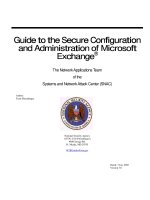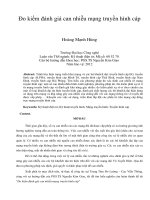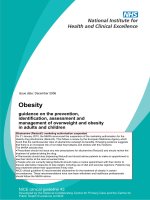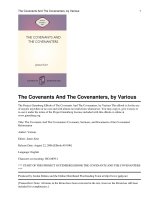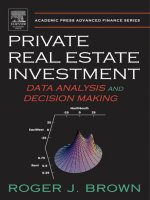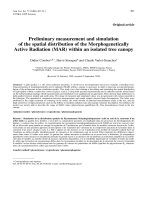The ex ante measurement and modeling of direct real estate investment risk
Bạn đang xem bản rút gọn của tài liệu. Xem và tải ngay bản đầy đủ của tài liệu tại đây (832.17 KB, 163 trang )
THE EX ANTE MEASUREMENT AND MODELING OF
DIRECT REAL ESTATE INVESTMENT RISK
LI YUN
M.A. (Finance), Fudan University, 2003
A THESIS SUBMITTED
FOR THE DEGREE OF DOCTOR OF PHILOSOPHY
DEPARTMENT OF REAL ESTATE
NATIONAL UNIVERISITY OF SINGAPORE
2007
I
ACKNOWLEDGEMENT
I am indebted to all those who have assisted in the development and
completion of this PhD thesis:
Associate Professor (Dr.) David Ho Him Hin, to whom I am most grateful and
indebted for the excellent supervision. His patience and availability, thorough
editing, and insightful suggestions are exemplary. Thank you very much for
your encouragement and the all the inspiring me to do a good research and
publication!
Associate Professor (Dr.) Ong Seow Eng, for his timely reminders and help
for the purpose of speeding up my research process, his insightful comments
and review of my research, and his wonderful co-supervision for my PhD
research. Genuine thanks to your kind help for all the difficulties during my
research!
Associate Professor (Dr.) Fu Yuming, together with his warm-hearted family,
who has all the time shown great concern for my research and PhD study;
sincere thanks to you for the research insights, techniques, encouragement,
II
advice and co-supervision guidance to my thesis writing!
Professor (Dr.) John Glascock, with whose provoking thoughts and insightful
comments, this thesis is directed to explore the real estate risk measurement
from a more meaningful and innovative perspective. Also millions of thanks to
him for his kind words, love and concern to me and my family, without which
my further PhD work will not possible! My appreciation of his kindness and
warm-heartedness is beyond my words.
Thanks to my colleagues from Dept of Finance Hong Kong University of
Science & Technology, especially Prof Sudipto Dasgupta, Prof John Wei, Prof
Kalok Chan, Prof Jonathan Batten, Dr. Junbo Wang and Sophie Ni together
with some other scholars for their insightful comments, without which this
version of paper will not be possible!
Thanks to the anonymous referees, Professor Ko Wang, and Dr. Michael S.
Young, for their deep insights and constructive suggestions on my academic
journal papers, which are indispensable components of this thesis! Thanks as
well to Dr. Clifford A. Lipscomb, Dr. S.G. Sykes, and the discussants and
participants at the 2006 American Real Estate Society Annual Meeting in Key
West, Florida for their helpful comments on the paper draft. The specific
III
recommendations on the improvement of this thesis are most appreciated.
Thanks to NUS for the opportunity to let me attend the Harvard College
China-India Development and Relationships Symposium (CIDRS) and the
Doctoral Student Network Asia Pacific Rim University (APRU), which give
me a chance to network with academics world widely.
Thanks to all the past and present graduate students and research assistants
whom I coincided with, for the opportunity to work with you, and to share the
difficulties and success of a research.
Most especial thankfulness to my wife, Mrs. Fang Le, for her encouragement,
support, patience, share of joys and pains of life and love, without which this
research would not have been possible; at the same time, I am equally
indebted to my parents, in-laws, younger brother and sister, for their
unconditional love, encouragement. This work is most lovingly dedicated to
them.
Deo Omnis Gloria!
IV
TABLE OF CONTENTS
Page No
Table of contents IV
Summary VII
References XIII
List of Appendices XIII
CHAPTER ONE INTRODUCTION
1.1 Background 1
1.2 Research Questions 6
1.3 Research Objectives 8
1.4 Research Contribution 9
1.5 The Theoretical Framework of Analysis 12
1.6 Research Hypotheses 27
CHAPTER TWO REVIEW OF RELATED LITERATURE
2.1 Traditional Risk Measures 29
2.2 Duration and Convexity 33
2.3 The LPM (Low Partial Moments) and Co-LPM Risks 41
2.4 Value at Risk (VAR) 46
2.5 The Risk Measurement Fitness 45
V
2.6 Literature Review on Real Estate Duration 47
CHAPTER THREE EMPERICAL MODEL VALIDATION OF
DIRECT REAL ESTATE EX ANTE SYSTEMATIC RISK & TOTAL
RISK BEHAVIOR UNDER DURATION RISK, TIME-VARYING RISK
AND GARCH RISK
3.1 Introduction 52
3.2 The Data Set 55
3.3 The Beta (Systematic Risk) Model Estimations 57
3.4 The Real Estate Asset Total Risk Estimation under the Duration and
GARCH Models 65
3.5 Concluding Comments 68
CHAPTER FOUR STRUCTURAL SIMULATION OF EX ANTE,
NON-NORMAL DIRECT REAL ESTATE RISK MEASURE &
RETURN BEHAVIOR
4.1 Introduction 71
4.2 The Theoretical Frame of Analysis 74
4.3 The Integrated Direct Real Estate Risk Measure Model 78
4.4 The Integrated Risk-measure Model Estimation 87
4.5 Concluding Comments 96
VI
CHAPTER FIVE CONLUSIONS AND IMPLICATIONS
5.1 Introduction 98
5.2 Conclusions about Research Questions 99
5.3 Theoretical Implications 101
5.4 Limitations and Recommendations for Further Research 102
VII
SUMMARY
Real estate assets such as office buildings and shopping centers play an important role
in the real estate portfolios of institutional investors, although they may well consist
of just a small part of such portfolios (Campbell and Viceira 1999 and
Ross and Zisler
1991 etc
). There are more institutional investors holding the view that real estate
assets should form an increasing share in their overall investment portfolios (Chun,
Ciochetti and Shilling 2004 and
Shoven and Sialm 1998 etc). Compared with the
publicly traded securities, such as equities (common stocks) and bonds, which make
up the vast majority of most institutional investor’s investment portfolios, real estate
assets differ markedly in key respects. While common stocks and bonds are liquid
and continuously traded, thereby making their market values readily observable, real
estate assets are illiquid and sporadically traded, thereby making real estate market
values rather difficult to observe. As for the publicly traded securities, there are
well-established time series of returns that can be utilized in the estimation of the
expected (future) risks and returns. However, this is not the case for new products in
the direct real estate investment markets. Owing to limited and empirical data
availability, an ex ante measurement and the modeling of direct real estate investment
risk would be significant and can offer promising scholarly investigative research in
real estate finance, particularly in such areas as the direct real estate expected return
estimation, asset allocation, portfolio management, risk monitoring and performance
VIII
measurement.
Investors in real estate, public or private, equity or debt, do evaluate their
risk-adjusted returns in the pursuit of specific goals. More often the overall approach
in practice is to anticipate direct real estate investment returns and not the
risk-adjusted investment returns (Ibbotson and Siegel 1994). The reality that practice
focuses on returns and not risk–adjusted returns is not because the real estate investor
has not read finance theories but because currently there is a lack of appropriate risk
measures. Hence, it is important to conduct an investigative research on the ex ante
measurement and modeling of direct real estate investment risk.
Dechow, Sloan and Soliman (2004) extend the traditional measure of bond duration
to equity analysis and develop an algorithm for the empirical estimation of implied
equity duration. They show that equity duration represents an important common
factor in stock returns; the book-to-market factor advocated by Fama and French
(1993) acts as a noisy proxy for an underlying duration factor. Equity duration
measure captures the risks of stocks and helps explain the cross section of returns
(Pedro, 2004; Dechow, Sloan and Soliman, 2004). An investigation of real estate
duration is of significant importance to the real estate asset pricing.
Campbell and Vuolteenaho (2003), Brennan and Xia (2003) and Bansal et al. (2002)
have tried to explain the value premium in the context of Merton’s Intertemporal
Capital Pricing Model (ICAPM). They argue that value firms are actually riskier than
IX
growth firms based on the covariance of their returns with changes in the investment
opportunity set. Campbell and Vuolteenaho (2003) use a discounted cash flow model
to decompose the market’s unexpected returns into news about future cash flows and
news about discount rates. In their model, the market may fall because there is bad
news about future cash flow or because of an increase in the discount rate.
Importantly, in the first case, the market falls but investment opportunities stay the
same, whereas in the second case, the market falls but further investment
opportunities actually improve due to the higher expected returns going forward. The
two components have different impact on long-term investors who hold the market
portfolio. Those investors demand a higher premium to hold assets that co-vary with
the market’s cash-flow news than to hold assets that co-vary with discount rate news.
Therefore cash-flow beta is “bad beta” since it commands a risk premium that is
several times larger than the (relatively) “good” discount-rate beta. Note that stocks
with high discount-rate (which are similar to stocks with high duration) are still risky
for a long–term investor. Campbell and Vuolteenahao (2003) only show that stocks
with high cash-flow risk are much riskier.
Campbell and Vuolteenhao (2003) find that discount-rate betas are a little greater for
value stocks than for growth stocks, but cash-flow betas are much greater for value
stocks than for growth stocks. The difference in the premia for each type of risk
explains the difference between returns of value and growth stocks. For a similar
story to justify the difference in return of high-duration and low-duration stocks, we
would need to find that low-duration stocks (low discount-rate beta) have much
X
higher cash-flow beta than high-duration stocks. Only then will their risks to
long-term investors justify their high returns.
In summary, equity duration is a thought-provoking new approach to measuring stock
risk. The relation between equity duration and returns deepens the already famous
asset pricing puzzle. Similarly, an exploration of real estate duration under an ex ante
analysis is of the essence and will surely direct us to a better understanding of real
estate investment risk and real estate asset pricing.
This research however seeks to generate risk measures for direct real estate that can
be used in real estate investment for both fundamental analysis (as it relates to leasing
markets) and investment analysis (as it is asset related). The real estate markets do
have some significant degree of statistical predictability (Mei and Liu 1993, Wheaton
and Torto 2001); it is the uncertainty associated with the anticipation of market
outcomes, and not the inherent historical variability of the market itself, that is the
key measure of risk. The historical variability is appropriate only in cases where the
anticipated (future) risk is similar to what (the used portion of) the historical risk had
been, and where the future variability does not contain a significant predictable
element.
Thus, this thesis is organized in the following manner:
In Chapter one, after an introduction, it goes in detail the Research Background,
XI
Research Questions, Research Objectives, Research Contribution, the Theoretical
Framework of Analysis (TFA) and Research Hypotheses.
Chapter two introduces real estate risk measurement like the traditional risk measures
that include variance or standard deviation, the Pearson correlation coefficient, the
beta
β
, skewness and kurtosis, duration and convexity, the LPM (Low Partial
Moments), Co-LPM, and the VaR (value at risk). The advantages and disadvantages
of these risk measures are discussed. The corresponding risk measurement fitness
problem is also discussed while the research objective, expected results and the
research contribution are next examined.
Chapter three presents a theoretical and empirical investigation of the non-linear
exposure measurements of direct real estate systematic risk and direct real estate total
risk under the ex ante duration risk, the time-varying beta risk and the GARCH
(generalized autoregressive conditional heterogeneity) risk. In this chapter, the author
first reviews several traditional definitions and measures of direct real estate
investment risk and then proposes a forward-looking and useful methodology, which
uniquely and rigorously integrates the duration risk model with the direct real estate
equivalent yield valuation model. A further empirical validation is conducted to
estimate the direct real estate duration beta and the associated time-varying beta,
within the context of Singapore’s real estate market that comprises the luxury
residential, prime office and retail sectors. Consequently, the resulting modified
XII
duration model is restructured to estimate the direct real estate total risk that in turn is
assessed in comparison with the GARCH risk model.
In Chapter four, a new parametric modeling of the ex ante direct real estate risk
measure and the corresponding return estimation is discussed. While, the direct real
estate risk modeling in Chapter three does not make any strict requirements with
regard to the stochastic distribution of the real estate return, Chapter four’s parametric
modeling takes the Beta distribution function to represent the direct real estate return
distribution. Thus, Chapter four investigates the merits of a unique direct real estate
risk-and-return estimation model, which rigorously integrates the bond
duration-convexity concept, the Beta distribution function and the direct real estate
equivalent yield valuation model. In such a unique model, limited information is
provided through the lease structure of a direct real estate asset. It is imperative to
note that no historical data is utilized while estimating the direct real estate risk and
the direct real estate expected return via this model. Such a model offers a useful and
innovative approach to the risk-and-return estimation of new direct real estate assets,
which do not have past time series. Lastly, Chapter five concludes this research’s
findings and results. In this part, implications for both theory and practice and policy
are briefed together with research limitations and implications for further research in
the end.
XIII
List of Tables
Table 2.1 Properties of Duration 36
Table 3.1 Statistical Analysis of Prime Real Estate Sectors, Singapore 56
Table 3.2 Summary of Normality Tests for Prime Real Estate Sectors, Singapore 57
Table 3.3 Correlation Matrix of Duration Beta and Time-varying Regression Beta 64
Table 3.4 Comparison of Duration Beta and Time-varying Regression Beta 65
Table 3.5 Estimated GARCH (1, 1) Model for Total Risk, Singapore’s Real
Estate Market 67
Table 4.1 Market values to be imputed into the model 99
Table 4.2 Summary of Modified Duration Simulation Results 90
Table 4.3 Summary of Simulation Results for Total Returns less than Target 91
Table4.4 Results of the Probability of Total Returns < Riskless Returns from
Simulation 93
Table 4.5 Sensitivity Results on Modified Duration with Marginal Change in the
Equivalent Yield 94
Table 4.6 Sensitivity Results on Modified Duration with Marginal Change in the
Rental Value (RV) 95
Table 4.7 Risk Estimates via Low Partial Moment (LPM) Approach 96
List of Figures
Fig 1.1 Theoretical Frame of Analysis 13
Fig 1.2 The Term and Reversion Parts of the Direct Real Estate Asset Equivalent
Yield Model 19
Fig 2.1 Convexity and Modified Duration 38
Fig 3.1 Beta Estimates of the Real Estate Sectors’ Return Volatility 60
Fig 3.2 Comparison of Duration Beta and Time-Varying Regression Beta 63
Fig 3.3 Comparison of GARCH and Duration Measures of Total Risk 68
Fig 4.2 The “Harry Potter” Sub-Model Flow Chart 82
XIV
REFERENCES…………………………………………………………105
APPENDICES
APPENDIX 1.1: The Mathematic Proof of Eq (1.17)…………….….113
APPENDIX 1.2: The Mathematic Derivation of Eq (1.29)………….115
APPENDIX 3.2: The Duration Betas of the Three Prime Real Estate
Sectors…………………………………………… 117
APPENDIX 3.3: The Time Varying Betas of the Three Prime Real Estate
Sectors………………………………………………121
APPENDIX 4.2: The MATLAB Program for the “Harry Potter”
Sub-Model………………………………………… 124
APPENDIX 4.3: Screen Shot of the Main Aspects of the Duration-Risk
Model……………………………………………… 127
APPENDIX 4.4: Market Data by JLL…………………………………128
APPENDIX 4.5: Calculations for Current Income and Its Range…… 132
APPENDIX 4.6: Treasury Bill Rates from SGS……………………….133
APPENDIX 4.7: Hong Kong Exchange Fund Bill Rates………………134
APPENDIX 4.8: Crystal Ball Simulation Report for Raffles………… 135
APPENDIX 4.9: Crystal Ball Simulation Report for Shenton………….143
1
CHAPTER ONE
INTRODUCTION
1.1 Background
Real estate assets such as office buildings and shopping centers play an important role in the real
estate portfolios of institutional investors, although they may well consist of just a small part of
such portfolios
1
. There are more institutional investors holding the view that real estate assets
should form an increasing share in their overall investment portfolios
2
. Compared with the
publicly traded securities, such as equities (common stocks) and bonds, which make up the vast
majority of most institutional investor’s investment portfolios, real estate assets differ markedly in
key respects. While common stocks and bonds are liquid and continuously traded, thereby
making their market values readily observable, real estate assets are illiquid and sporadically
traded, thereby making real estate market values rather difficult to observe. As for the publicly
traded securities, there are well-established time series of returns that can be utilized in the
estimation of the expected (future) risks and returns. However, this is not the case for new
products in the direct real estate investment markets. Owing to limited empirical data availability,
an ex ante measurement and the modeling of direct real estate investment risk would be
significant and can offer promising scholarly investigative research in real estate finance,
particularly in such areas as the direct real estate expected return estimation, REITs (Real Estate
1
See Campbell and Viceira (1999) and Ross and Zisler (1991) etc.
2
Chun et al (2004) state that institutional investors were to invest more in real estate (up to 12
percent of their assets), they should be able to eliminate non-market or unique risk, while in
practice institutional investors hold only between 2 and 3 percent of their assets in real estate. See
also Shoven and Sialm (1998); Ibbotson and Siegel (1983) etc.
2
Investment Trusts) asset pool pricing, asset allocation, portfolio management, risk monitoring and
performance measurement.
Investors in real estate, public or private, equity or debt, do evaluate their risk-adjusted returns
in the pursuit of specific goals. More often the overall approach in practice is to anticipate
direct real estate investment returns and not the risk-adjusted investment returns
3
. The reality
that practice focuses on returns and not risk-adjusted returns is not because the real estate
investor has not read finance theories but because of the lack of appropriate risk measures. In
conformity with modern portfolio theory, the measurement of real estate risk should reflect an
investor’s ex ante expectations, rather than focus on what has happened in the past. Historic
measures of risk are merely helpful in forecasting expected risk under set scenarios. In
modeling real estate risk, it should not be measured in function of what happened (i. e., actual
past volatility) but in function of what might have happened and its probability. Hence, it is
important to conduct an investigative research on the ex ante measurement and modeling of
direct real estate investment risk.
Dechow, Sloan and Soliman (2004) extend the traditional measure of bond duration to the equity
analysis and develop an algorithm for the empirical estimation of implied equity duration. It
shows equity duration represents an important common factor in stock returns; the
book-to-market factor advocated by Fama and French (1993) acts as a noisy proxy for an
underlying duration factor. Equity duration measure captures the risks of stocks and helps explain
the cross section of returns
4
(Pedro 2004; Dechow, Sloan and Soliman 2004). An investigation of
real estate duration is of significant importance to real estate asset pricing.
3
See Ibbotson and Siegel (1994), Wheaton et al (2001).
4
One reductionism way to view such equity duration measurement in Dechow, Sloan and
Soliman (2004) is that it is a composite of the firm’s characteristics such as the firm’s book value
of equity, market value of equity, sales and earnings. See Pedro (2004).
3
Campbell and Vuolteenaho (2003), Brennan and Xia (2003) and Bansal et al. (2002) have tried to
explain the value premium in the context of Merton’s Intertemporal Capital Pricing Model
(ICAPM). They argue that value firms are actually riskier than growth firms based on the
covariance of their returns with changes in the investment opportunity set. Campbell and
Vuolteenaho (2003) use a discounted cash flow model to decompose the market’s unexpected
returns into news about future cash flows and news about discount rates. In their model, the
market may fall because there is bad news about future cash flow or because of an increase in the
discount rate. Importantly, in the first case, the market falls but investment opportunities stay the
same, whereas in the second case, the market falls but further investment opportunities actually
improve due to the higher expected returns going forward. The two components have different
impact on long-term investors who hold the market portfolio. Those investors demand a higher
premium to hold assets that co-vary with the market’s cash-flow news than to hold assets that
co-vary with discount rate news. Therefore cash-flow beta is “bad beta” since it commands a risk
premium that is several times larger than the (relatively) “good” discount-rate beta. Note that
stocks with high discount-rate (which are similar to stocks with high duration) are still risky for a
long–term investor. Campbell and Vuolteenahao (2003) only show that stocks with high
cash-flow risk are much riskier.
Campbell and Vuolteenhao (2003) find that discount-rate betas are a little greater for value stocks
than for growth stocks, but cash-flow betas are much greater for value stocks than for growth
stocks. The difference in the premia for each type of risk explains the difference between returns
of value and growth stocks. For a similar story to justify the difference in return of high-duration
and low-duration stocks, low-duration stocks (with low discount-rate beta) should have much
higher cash-flow beta than high-duration stocks, for which risks to long-term investors justify
their high returns.
4
In summary, equity duration is a thought-provoking new approach to measuring stock risk. The
relation between equity duration and returns deepens our understanding of the famous size and
value premium puzzles. While there is more research into the application of duration to equities,
very few studies have examined the duration of commercial real estate. Hence, an exploration of
real estate duration under an ex ante analysis is should direct us to a better understanding of real
estate investment risk and real estate asset pricing.
This research seeks to generate risk measures for direct real estate that can be used in real estate
investment for both the real estate fundamental analysis (as it relates to the leasing markets such
as rental income) and investment analysis (asset related, such as real estate asset return). The real
estate markets do have some significant degree of statistical predictability
5
; it is the uncertainty
associated with the anticipation of market outcomes, and not the inherent historical variability of
the market itself, that is the key measure of risk (Wheaton et al 2001). The historical variability is
appropriate only in cases where the anticipated (future) risk is similar to what (the used portion of)
the historical risk had been, and where the future variability does not contain a significant
predictable element.
Thus, this thesis is organized in the following manner:
In Chapter one, after an introduction, it goes in detail the Research Background, Research
Questions, Research Objectives, Research Contribution, the Theoretical Framework of Analysis
(TFA) and Research Hypotheses.
5
Chun et al (2000) reveal real estate return is predictable. The amount of predictability in real
estate returns is almost the same in stock returns. See also Mei and Liu (1992), Wheaton and
Torto (2001).
5
Chapter two introduces real estate risk measurement like the traditional risk measures that include
variance or standard deviation, the Pearson correlation coefficient, the beta
β
, skewness and
kurtosis, duration and convexity, the LPM (Low Partial Moments), Co-LPM, and the VaR (value
at risk). The advantages and disadvantages of these risk measures are discussed. The
corresponding risk measurement fitness problem is also discussed. In the end of this chapter,
literature review on the real estate duration and equity duration is made.
Chapter three presents a theoretical and empirical investigation of the non-linear exposure
measurements of direct real estate systematic risk and direct real estate total risk under the ex ante
duration risk, the time-varying beta risk and the GARCH (generalized autoregressive conditional
heterogeneity) risk. It first reviews several traditional definitions and measures of direct real
estate investment risk and then proposes a forward-looking and useful methodology, which
uniquely and rigorously integrates the duration risk model with the direct real estate equivalent
yield valuation model. A further empirical validation is conducted to estimate the direct real estate
duration beta and the associated time-varying beta, within the context of Singapore’s real estate
market that comprises the luxury residential, prime office and retail sectors. Consequently, the
resulting modified duration model is restructured to estimate the direct real estate total risk that in
turn is assessed in comparison with the GARCH risk model.
In Chapter four, a new parametric modeling of the ex ante direct real estate risk measure and the
corresponding return estimation is discussed. However, comparatively the direct real estate risk
modeling in Chapter three does not make any strict requirement of the real estate return
distributions, Chapter four’s parametric modeling takes the Beta distribution function to represent
the direct real estate return distribution. Thus, Chapter four investigates the merits of a unique
direct real estate risk-and-return estimation model, which rigorously integrates the bond
6
duration-convexity concept, the Beta distribution function and the direct real estate equivalent
yield valuation model. In such a unique model, limited information is provided through the lease
structure of a direct real estate asset. It is imperative to note that no historical data is utilized
while estimating the direct real estate risk and the direct real estate expected return via this model.
Such a model offers a useful and innovative approach to the risk-and-return estimation of new
direct real estate assets, which do not have past time series.
Lastly, Chapter five concludes this research’s findings and results. In this part, implications for
both theory and practice and policy are briefed together with research limitations and implications
for further research in the end.
1.2 Research Questions
Like investors in the bond, stock markets, the real estate investors are in pursuit of higher return
subject to a certain risk level. However, in reality, real estate investors focus on returns but not
risk-adjusted returns
6
. This is not because the real investors have not read finance theory, but
because there is a lack of appropriate risk measures, especially for the newly built and sparsely
transacted properties where past time series data is not available. Hence, an understanding of the
risk behavior in direct real estate investment is of high priority for investors. What is the risk
pattern of a direct real estate asset (or sector)? Does a higher expected return result from higher
risk? In the lack of past time series of the newly built or rarely transacted properties, is it possible
to make use of the information available in the market to investigate their risk pattern or even
generate an accurate estimation of their risk and return while from an ex ante perspective?
6
See Ibbotson and Siegel 1994, Wheaton et al 2001.
7
Theoretical and empirical research
7
shows that equity duration represents an important common
factor in stock returns; the book-to-market factor advocated by Fama and French (1993) acts as a
noisy proxy for an underlying duration factor. Equity duration measure captures the risks of
stocks and helps explain the cross section of stock returns. Can the duration measure of direct real
estate investment assets capture the risks of the real estate investment? Answering these questions
offers good potential in a number of areas such as real estate expected return estimation, asset
allocation, portfolio management, risk monitoring and performance measurement and will fill a
knowledge gap concerning the pricing of the direct real estate.
In the direct (private) market, the absence of a transparent marketplace leads to asymmetric
information and the absence of transaction-based data. Reported returns are frequently based on
appraisals of value rather than sales information. This has important implications for the
modeling of returns distributions. Young and Graff (1996) and Liu et al. (1992) propose that real
estate is not normal and their findings broadly confirm those of Miles and McCue (1984) and
Hartzell et al. (1986) who find evidence of non-normality in terms of skewness and kurtosis, and
Myer and Webb (1994) who provide evidence of non-normal kurtosis and autocorrelation in
direct (private) real estate returns.
Myer and Webb (1993) analyze quarterly returns from a small sample of REITs over the period
1978-1990 and they find that individual REITs have significant skewness and kurtosis and are
non-normal by at least one of the normality tests employed, while a composite index of REITs
shows no evidence of non-normality. Lizieri and Satchell (1997) propose a log normal
distribution for the monthly property company returns in the UK between 1972 and 1992. Sieler
et al. (1999) examine the return distributions of equity real estate investment trusts (EREITs) for
7
See Pedro (2004), Dechow et al (2004), Campbell and Vuolteenaho (2003), Brennan and Xia
(2003) and Bansal et al. (2002).
8
quarterly data from 1986 to 1996. The Kolmogorov-Smirnov, Shapiro-Wilks and Lilliefors tests
generally reject normality, despite the small number of observations. By sector, Office REIT
returns appear the least normal, while the tests do not reject normality for Industrial REITs. The
office returns are characterized by very high volatility, a low mean return and positive skewness.
Comparative figures for the direct market show office property returns exhibiting negative
skewness, a disturbing contradiction. As with Myer and Webb (1993), comparative direct market
returns are shown to be non-normal.
In conclusion, the real estate return distribution is much illusive and will be changing with
different types of real estate investment, sectors of real estate market, and even intervals of return
measurement. An investigation of an appropriate real estate return distribution is critical for the
direct real estate investment risk behavior exploring, which consists of one of my research
questions in this study. Answering this question will lead to a better understanding of the risk
behavior and shed light on the pricing of underlying direct real estate assets consisting of a
mortgage asset pool.
1.3 Research Objectives
The Four main objectives of this research consist of the following:
• To rigorously model an ex ante risk measure of the direct real estate systematic risk and
the direct real estate total risk, in terms of the non-linear exposure to movements in the
direct real estate yield;
• To carry out an empirical validation in order to estimate the direct real estate duration
9
beta and the time-varying beta, within the context of Singapore’s real estate market that
comprises the luxury residential, the prime office and the retail sectors;
• To restructure the resulting and ex ante direct real estate modified duration model in
order to estimate the direct real estate total risk, which in turn is assessed in comparison
with the GARCH (generalized autoregressive conditional heterogeneity) risk model;
• To model a unique direct real estate risk-and-return estimation that integrates the bond
duration-convexity concept, the Beta distribution function and the direct real estate
equivalent yield valuation model. Limited information is being provided through the
lease structure of a direct real estate asset, and no historical data is utilized.
1.4 Research Contribution
Several original research contributions are duly noted in this study. To overcome the limited data
availability for direct real estate investments and the poor quality (i.e. the temporal lagging error)
of appraisal-based real estate return data, the investigative research proposes a unique ex ante
modeling of direct real estate risk. To investigate such ex ante modeling, this research makes use
of well-defined financial theory (viz. the duration and convexity together with the CAPM model)
through combining the specific direct real estate equivalent-yield valuation model. The achieved
ex ante direct real estate investment risk model provides a meaningful insight on direct real estate
investment risk behavior under a modified duration model. Further modeling of other real estate
investment risks like the low partial moment (LPM), the systematic risk, the total risk and the
GARCH risk are explored on the basis of the modified duration model. In addition, an empirical
validation is conducted in order to estimate the direct real estate duration beta and the
10
corresponding time-varying beta but within the context of Singapore’s real estate market, which
comprises the luxury residential, prime office and prime retail sectors. Consequently, the
resulting modified duration model is restructured in order to estimate the direct real estate total
risk that in turn is assessed in comparison with the GARCH risk model. These models are
dynamic partial equilibrium models, and are consistent with the modern general equilibrium
theory, and extend beyond the single-factor capital asset pricing model and the multi-factor
arbitrage pricing model for common stocks, which both are general equilibrium pricing models.
The subsequent empirical analysis shows that the modified duration, which is often used in the
price analyses of fixed-income assets (i.e. bonds) and common stocks, has the potential of being
uniquely modified to obtain the direct real estate duration model for a real estate sector or its
wider real estate market. The direct real estate duration model can then be structurally modeled in
order to estimate the return volatility of a direct real estate asset (or sector) relative to its real
estate market, i.e. the real estate sector’s systematic risk, as well as the particular real estate
sector’s or market’s total risk. The direct real estate duration model can even be based on
information readily available and known to the valuer. No past time series data is involved. Thus,
the direct real estate duration model offers good potential in several areas like estimating the
direct and expected real estate returns, the direct real estate asset allocation, direct real estate risk
monitoring and performance measurement.
From a corresponding in-depth empirical investigation of the prime real estate sectors of
Singapore and utilizing the JLL REIS-Asia data set, the derived duration betas for the prime
office sector and the prime retail sector are on the whole very stable, relative to the prime luxury
residential sector. Furthermore, the negative correlation between the duration beta of the prime
retail and office sectors highlights the importance of diversification for a long-term investment in
these two prime sectors.

